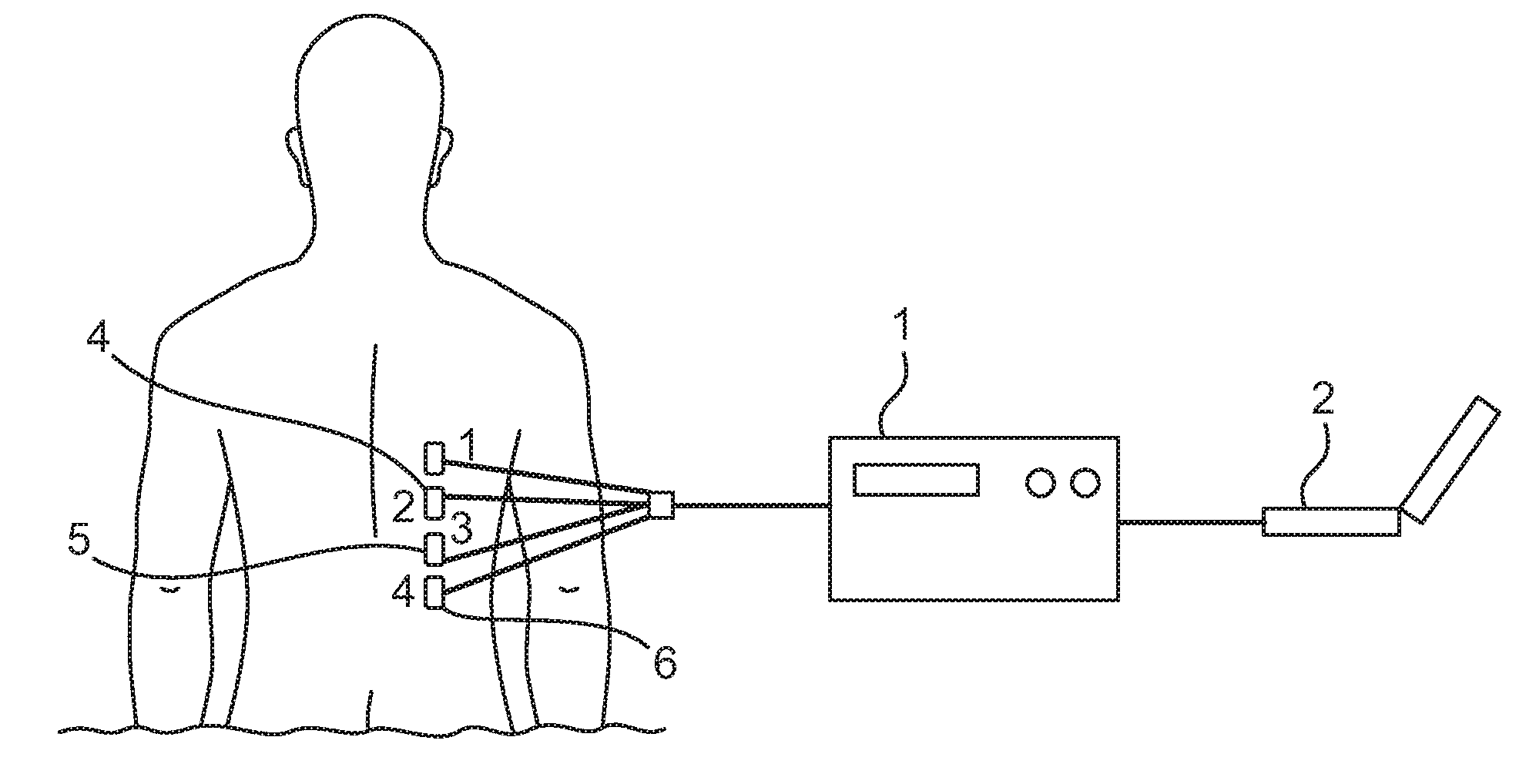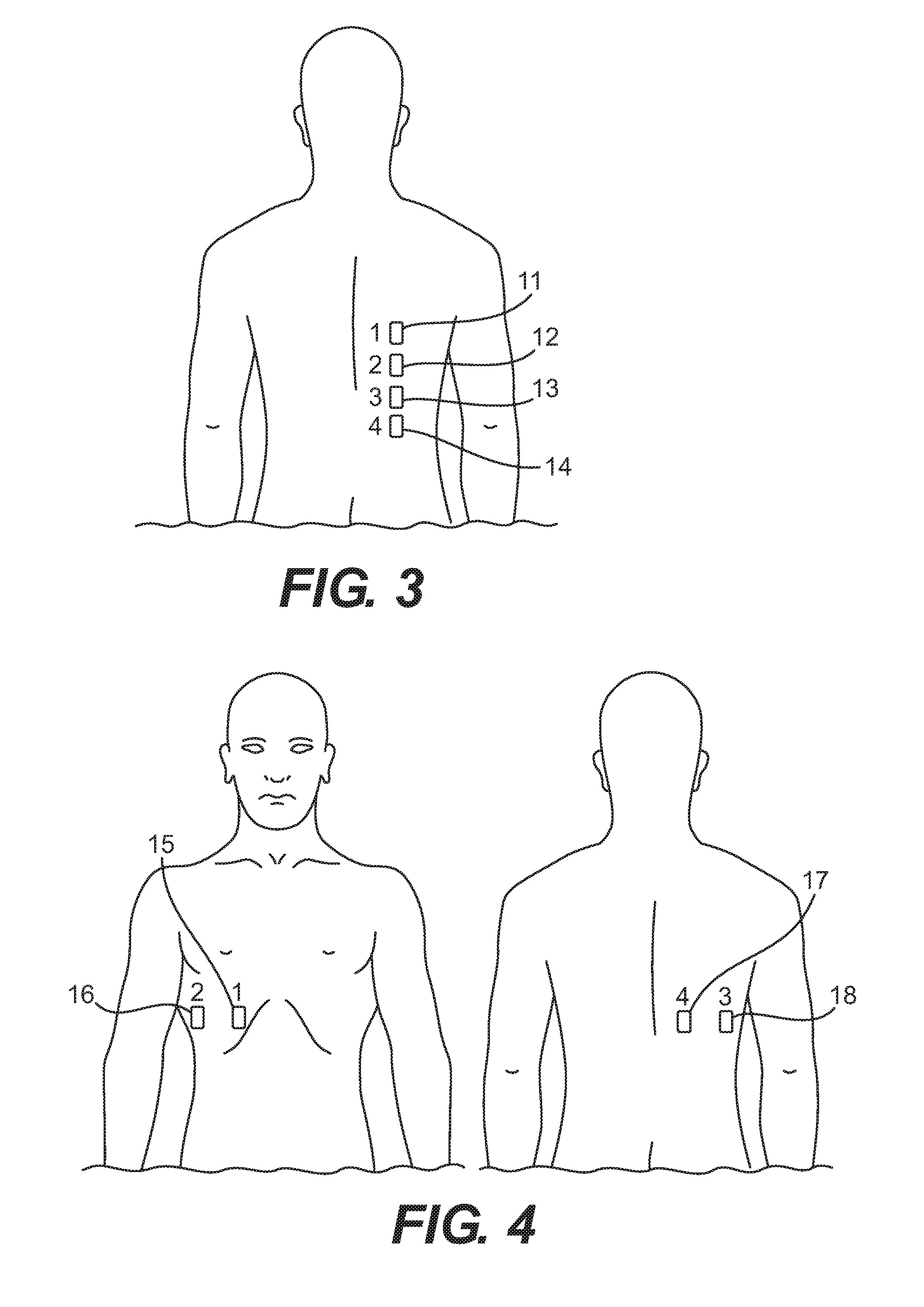However, it would still take time before scientists recognized the advantages of monitoring a physiological signal in a clinical environment.
Furthermore, differences in currently monitored
vital signs such as
blood oxygenation occur late in the progression of respiratory or circulatory compromise.
However,
respiratory rate alone fails to indicate important physiological changes, such as changes in respiratory volumes.
However, there are currently no adequate systems that can accurately and conveniently determine respiratory volumes, which motivates the need for a non-invasive respiratory monitor that can trace changes in breath volume.
These methods are often inconvenient to use and inaccurate.
While
end tidal CO2 monitoring is useful during
anesthesia and in the evaluation of intubated patients in a variety of environments, it is inaccurate for non-ventilated patients.
The
spirometer and pneumotachometer are limited in their measurements are highly dependent on patient effort and proper coaching by the clinician.
However, these two prerequisites are not necessarily enforced in clinical practice like they are in research studies and pulmonary function labs.
The major drawback of mainstream spirometers is that they require the patient to breathe through a tube so that the volume and / or flow rate of his breath can be measured.
Thus it is impossible to use these devices to accurately measure a patient's normal
breathing.
Also, many physicians do not have the skills needed to accurately interpret the data gained from pulmonary function tests.
According to the American Thoracic Society, the largest source of intrasubject variability is improper performance of test.
Impedance-based
respiratory monitoring fills an important void because current spirometry measurements are unable to provide continuous measurements because of the requirement for patient cooperation and
breathing through a tube.
Even with acceptable spirometry measurements, the interpretations of the data by primary physicians were deemed as incorrect 50% of the time by pulmonologists.
However, resources to
train a large number of people and enforce satisfactory
quality assurance are unreasonable and inefficient.
Even in a dedicated research setting,
technician performance falls over time.
In addition to
human error due to the patient and healthcare provider, spirometry contains systematic errors that ruin
breathing variability measurements.
Also, the discomfort and inconvenience involved during measurement with these devices prevents them from being used for routine measurements or as long-term monitors.
Other less intrusive techniques such as thermistors or strain gauges have been used to predict changes in volume, but these methods provide poor information on respiratory volume.
Respiratory belts have also shown promise in measuring
respiration volume, but groups have shown that they are less accurate and have a greater variability than measurements from impedance pneumography.
Specifically, elderly patients and patients with pulmonary diseases may be at risk for respiratory complications when placed under a ventilator for
surgery.
However, these tests cannot be replicated mid-
surgery, or in narcotized patients or those who cannot or will not cooperate.
Testing may be uncomfortable in a postoperative setting and disruptive to patient
recovery.
Unfortunately, it is generally inaccurate and difficult to implement in the non-ventilated patient, and other complementary
respiratory monitoring methods would have great utility.
Fenichel et al. determined that
respiratory motion can cause interference with echocardiograms if it is not controlled for.
These effects on the echocardiography signal can decrease the accuracy of measurements recorded or inferred from echocardiograms.
They reported difficulty in separating the cardiac signal artifacts and also noted artifacts during body movements.
They have a low resistivity in the longitudinal direction but a
high resistivity in all other directions, which leads to a tendency to conduct current in a direction that is parallel to the
skin.
Another potential signal artifact comes from subject movements, which may move electrodes and disturb calibrations.
Furthermore,
electrode movements may be more prevalent in obese and elderly patients, which may require repetitive lead recalibration during periods of long-term monitoring.
The inability for a patient to separate from a
mechanical ventilator occurs in approximately 20% of patientsand current methods to predict successful separation are poor and add little to a physician's decision.
While certain contact probes
record respiratory rate, to date, no device or method has been specifically devised to
record or to analyze respiratory patterns or variability, to correlate respiratory patterns or variability with physiologic condition or viability, or to use respiratory patterns or variability to predict impending collapse.
However, the implications of the rate, which is the only parameter objectively monitored is frequently not identified soon enough to best treat the patient.
However, patients are discouraged from pressing the button if they are getting too drowsy as this may prevent therapy for quicker
recovery.
It is caused by damage to the lungs over many years, usually from smoking.
This can narrow or block the airways, making it hard for you to breathe.
However, with emphysema, these
air sacs are damaged and lose their stretch.
Less air gets in and out of the lungs, which causes shortness of breath.
COPD patients often have difficulty getting enough
oxygenation and / or CO2 removal and their breathing can be difficult and labored.
Long-term issues include difficulty breathing and coughing up
sputum as a result of frequent
lung infections.
Each of these therapeutic methods has a common drawback, there is no way of knowing how much air is actually getting into the lungs.
This can be inaccurate and is not a direct measurement of
oxygen ventilation.
Furthermore, therapies using masks can be inaccurate due to leakage and problems associated with
mask placement.
Additionally, kinking and malfunctions in the pneumatic
airway circuits can provide and inaccurate measure of the amount of air which is getting into the lungs
 Login to View More
Login to View More  Login to View More
Login to View More 


